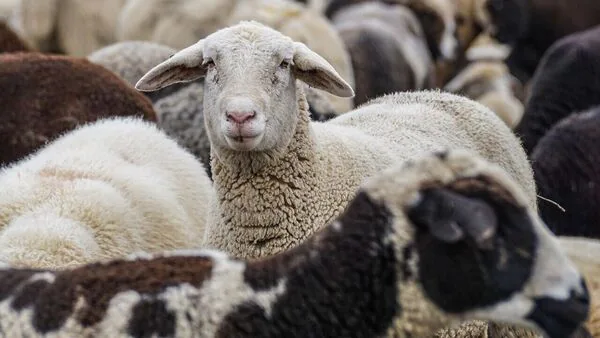Not Just Humans Sheep, Goats, Llamas And Guanacos Also Fall For Classic Optical Illusions
Schaffer and her research team ran two food-based illusion tests using the Müller-Lyer illusion (the lines with arrowheads that make one stick look longer than the other) and the Delboeuf illusion (where identical-looking circles look bigger or smaller depending on their surrounds). The study involved 17 zoo-housed animals: guanacos, llamas, Skudde sheep, and Damara goats, all tested with a pair of food options to choose from.
In the Müller-Lyer test, the animals were presented with two identical carrot sticks, one framed with inward-pointing sticks and the other with outward-pointing ones. The group as a whole picked the carrot framed with inward arrows significantly more often, suggesting they perceived it as longer (even though it was not). In the Delboeuf test, they saw identical snacks surrounded by circles of different sizes. More often than chance, the animals went for the treat inside the smaller circle, hinting they thought it looked larger than the one inside the bigger circle.
Also read: Optical illusion: Try to find out all the missing animals in this mind-bending challenge
This is not just a quirky fact about goats being gullible. The findings suggest that ungulate vision may share neural mechanics with humans. Despite having side-positioned eyes, giving them a wide field of view but less depth perception, they still fall for visual context tricks. That means cognitive processing of size and shape may be more universally wired than we thought.
Alina Schaffer, who is based at the University of Leipzig, helmed the project. Her aim? To peek“inside these animals' heads” and figure out if their visual perception echoes ours.
Understanding how these animals perceive their world is not just academic. It could improve how we design environments and enrichments for animals in captivity, promoting not only their welfare but our empathy too.
FAQsQ: What optical illusions were tested in the study?A: The Müller-Lyer illusion (lines with arrowheads) and the Delboeuf illusion (circles within circles) were used to test visual perception in ungulates.
Q: Which animals participated in the study?A: The researchers tested 17 zoo-kept animals: guanacos, llamas, Skudde sheep, and Damara goats.
Q: Who led the research?A: Alina Schaffer, at the University of Leipzig in Germany, led the study with support from colleagues.
Q: What did the animals do in the Müller-Lyer test?A: They tended to choose the carrot stick placed between inward-pointing arrowheads, perceiving it as longer than it actually was.
Q: How did they respond to the Delboeuf illusion?A: They mostly selected treats inside smaller circles, indicating they perceived them as larger, an illusion similar to humans.
Legal Disclaimer:
MENAFN provides the
information “as is” without warranty of any kind. We do not accept
any responsibility or liability for the accuracy, content, images,
videos, licenses, completeness, legality, or reliability of the information
contained in this article. If you have any complaints or copyright
issues related to this article, kindly contact the provider above.
Most popular stories
Market Research

- Seoul Exchange, One Of Only Two Licensed Platforms For Unlisted Securities, Will Exclusively Use Story To Settle Tokenized Rwas
- Phase 6 Reaches 50% Mark As Mutuum Finance (MUTM) Approaches Next Price Step
- 0G Labs Launches Aristotle Mainnet With Largest Day-One Ecosystem For Decentralized AI
- Solotto Launches As Solana's First-Ever Community-Powered On-Chain Lottery
- Kintsu Launches Shype On Hyperliquid
- Blockchainfx Raises $7.24M In Presale As First Multi-Asset Super App Connecting Crypto, Stocks, And Forex Goes Live In Beta






















Comments
No comment